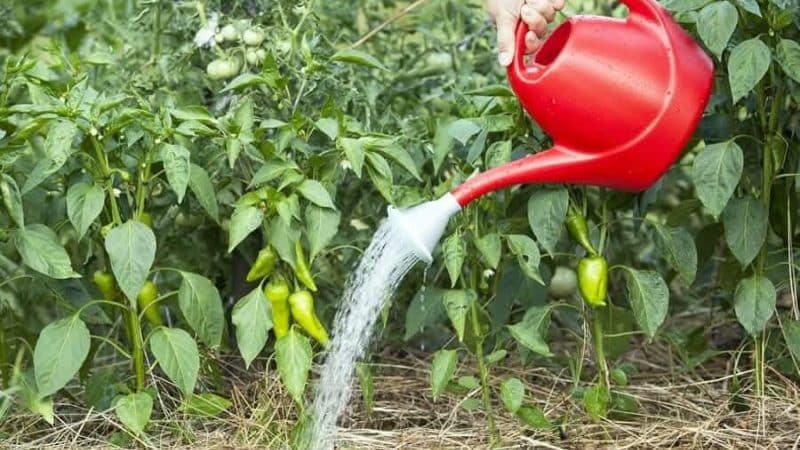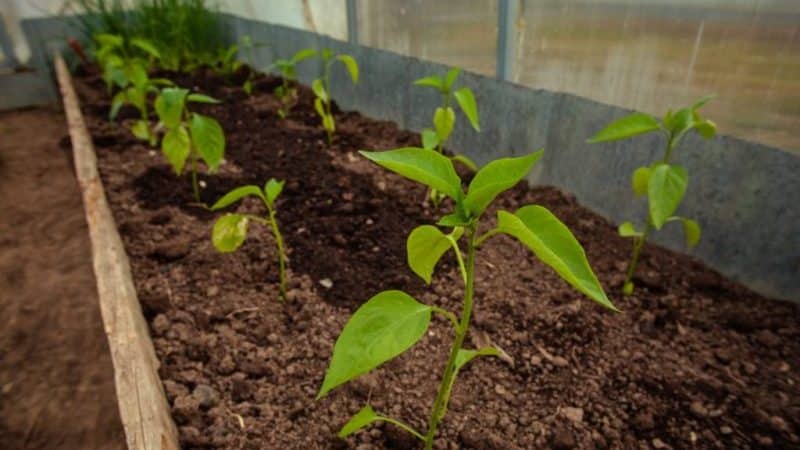Fertilizers for bell peppers: what to feed in open ground for growth and thickness
The beds decorated with multi-colored peppers inevitably make one think of a New Year tree. Making this miracle a reality on your own site will allow you to create conditions favorable for the plant. Caring for peppers, regardless of the variety, consists not only of covering and watering, but also of enriching the soil.
Our article will tell you how, when and what to feed peppers to get a rich harvest.
What is the best way to feed peppers in a greenhouse?
Compared to other common vegetables, sweet and bitter peppers are moisture-loving and have a long development period - at least 90 days pass from the moment of germination to the full ripening of the first fruits. Therefore, it is recommended to grow peppers indoors, where a warm and humid microclimate is created.
Feedings are:
- preliminary – before planting the crop, the soil is mixed with a nutrient mixture;
- root – when the plant is planted and fertilizer is applied to the soil in the form of solutions;
- by air – using a spray bottle to promote the development of the aerial part.
In combination, all types of fertilizing give a noticeable effect - the vegetable actively growing and bears fruit.
In the greenhouse, a mixture of native (greenhouse) soil, humus and ash in a ratio of 3:1:1 is used for feeding. Apply the mixture to the holes before planting the seedlings. The first ingredient serves as a diluent, the second contains macro- and microelements, the third is potassium, necessary for flowering and fruiting.
To replenish nitrogen and phosphorus, at every third watering from the moment of planting seedlings or seedlings, add a 1% solution of nitrate and superphosphate (2 tablespoons of each product per 10 liters of water). 2-3 weeks before harvest Mineral fertilizing at the root is prohibited to prevent substances from getting into the fruit.
In the open ground
In open ground, in addition to preliminary and root fertilizing, spraying is used. It requires:
- clear and windless weather so that the drug quickly penetrates through the pores of the leaves;
- use of liquid or powder complex mineral fertilizer;
- compliance with the dosage indicated on the label so that the crop does not get burned;
- apply before flowering so as not to scare off pollinating insects.
On average, peppers are sprayed in open ground twice during the entire development period. The main emphasis is on preliminary soil preparation and watering with nutrient solutions.
Selection of fertilizers for bell peppers and hot peppers
Bell and hot peppers differ in color and taste, but they have the same nutritional requirements. Fertilizer is selected depending on the following factors:
- period of plant development;
- budget;
- growing conditions.
Like any other vegetable, pepper first requires nitrogen and phosphorus, and when ovaries form, potassium fertilizers. Often gardeners have to choose between economical, optimal and dynamic feeding.
If a farmer wants to get environmentally friendly vegetables, budget organics are suitable. In addition, after the “chemistry” the earth quickly wears out. Therefore, the best option is considered to be optimal - when organic matter is added to the soil first, and minerals are added along with watering.
Selection of fertilizing depending on the growth phase
Each fertilizer composition contains separate macroelements (nitrogen, phosphorus and potassium) and microelements (boron, iron, manganese, copper, zinc, etc.). Microelements are not as important as macroelements, since there are enough of them in the soil and organic fertilizers. In addition, microelements are produced by the plants themselves. But nitrogen, phosphorus and potassium are always in short supply, so they are given additionally to the plant depending on the growth phase.
Pepper seedlings
Young peppers need nitrogen and phosphorus - they are found in saltpeter and superphosphate, respectively. They are applied before sowing by mixing the soil for seedlings with humus in a ratio of 3:1.
Important. For additional feeding, pepper seedlings are watered with a 1% solution of nitrate and superphosphate every 15 days.
It is advisable to use complex fertilizer, for example, “Nitrofoska”, “Malyshok”, “Tsitovit”, “Tsitovit”, “Energen”.
After landing
According to statistics, experienced gardeners rarely soak seeds in a nutrient liquid before planting. But the corresponding event:
- accelerates seed germination;
- strengthens the immunity of seeds and future sprouts;
- allows you to get by with simple soil.
To pre-mineralize seeds, use a growth stimulator (not to be confused with a complex fertilizer), which can be purchased at a garden store:
- "Epin";
- "Zircon";
- "Kornevin";
- "Energen".
But if there was no soaking, then the drug is used immediately after planting the seeds according to the instructions.
After the pick
If nitrogen promotes the development of green mass, phosphorus strengthens the root system. Accordingly, picking (transplanting) peppers is accompanied by root feeding with superphosphate. The nutritional composition for seedlings is made weak - 1 tbsp. l. for 10 liters of water. Add 0.5 tbsp there. l. saltpeter and 1 tbsp. l. ash.
Water the vegetable with a phosphorus or complex solution not only during picking, but also 10 days after transplanting. The second step is especially relevant if a growth stimulator was used in the new place instead of a fertilizer.
Bloom
The flower opening phase of pepper occurs 65-80 days after germination. During this period, the vegetable most needs feeding in order to gain strength before fruiting. You can’t spray because of possible damage to the flowers, and it’s too late to apply soil fertilizing. All that remains is to water the plant with one of the following means:
- Manure emulsion – dilute one part of manure with ten parts of water, leave for three days and dilute with another three parts of water to create a watering solution.
- "Chatter" of humus (rotted manure or droppings) - one part of humus is diluted with five parts of water, left for 24 hours and diluted with 1-2 parts of water for irrigation solution.
- Mineral solution – a matchbox of “Nitrofoski” is dissolved in 10 liters of water.
Instead of organics and “Nitrophoska”, use any complex preparation containing sodium, phosphorus, and potassium. True, it will cost more.
Fruiting

During the fruiting period, the bush is fertilized “at the root” with a weak solution of organic matter, so as not to spoil the taste of the fruit. If, when transplanting seedlings, the holes were not filled with a nutrient mixture, then 2-3 weeks before fruiting, the seedlings are watered “at the root” with a mineral or organic solution.
When using natural macronutrients, the emphasis is on potassium. A 10% solution is made from the ash, left for 3-5 days and diluted with water in a ratio of 1:3 (1:5).
Feeding by month
Many people, instead of drawing up a feeding calendar, focus on months:
- June – spraying with a nitrogen solution, watering “at the root” with a nitrogen-phosphorus formula;
- July – watering with a complex mixture;
- August - watering with a weak organic emulsion of ash, humus or manure.
But in the case of heat-loving pepper, such a schedule is relevant only in the south.
Attention! Northern regions require rearrangement of fertilizing depending on peaking, flowering, and fruiting.
How to feed peppers for good yield
To answer this question, consider the development cycle of a vegetable.

To grow
A quickly absorbed drug helps solve this problem:
- "Bogatyr";
- "Gumi Kuznetsova";
- "Emerald";
- "Strong."
They contain all the necessary macro- and microelements and are sold in liquid or powder form.
So that the fruits are large
Only healthy bushes produce large fruits. Three techniques contribute to such a harvest:
- Planting adult seedlings in holes filled with native soil, humus and ash in a ratio of 3:1:1.
- Watering newly transplanted seedlings with a “matter” of any complex fertilizer or organic (except ash).
- Watering flowering bushes with a solution of ash, humus, manure or droppings.
To have plump stems
A common cause of thin stems is a lack of sulfur. However, the plant suffers from a “graceful waist” even when there is a deficiency of nitrogen, phosphorus and potassium. In order not to guess what exactly pepper is missing, it is better to use a complex formula marked N, P, K, S. These include:
- "Azofoska" with sulfur;
- sulfoammophos and potassium magnesia.
These are traditional means. In addition to them, there are organo-mineral analogues, which are more expensive and contain more useful macro- and microelements.
When to fertilize
Seedlings are fed moderately.The choice of product depends on the development phase of the vegetable and the nutritional value of the soil.
How often to do this
If the nutrient mixture is added to the hole once - when transplanting seedlings, then the need for root enrichment multiplies many times:
- the first time - when planting seeds (optional);
- the second time - 10-14 days from the moment the seedlings emerge (required);
- the third time - 10-12 days before transplanting seedlings (required);
- the fourth time - during transplantation (required if a growth stimulator is used);
- fifth time - 10-14 days after transplantation (required);
- sixth time - during flowering (required);
- the seventh time - during fruiting (mandatory if organic liquid is used).
As for spraying, it is better to do this instead of the third and fifth root dressings.
Reference! To prepare the mixture for spraying, complex powder or granular formulations are used.
Useful tips for gardeners
Despite the variety of preparations, experienced gardeners still prefer the “old-fashioned” techniques:
- I quickly restore yellowed and limp bushes using a 2% solution of ammonia, which contains nitrogen;
- a solution of nettle, wormwood and ash (10:1:1:1) infused for 3-5 days is an organic alternative to “Nitrophoska”;
- the lack of macro- and microelements in the soil is easily compensated for by fresh mulch, which decomposes with each watering and releases useful substances to the root system;
- in order for the lateral ovaries to grow, the central flower is removed (in this case, the plant is fed with a double solution of organic matter);
- Ripe fruits are removed in time to give strength to the young ones.
Reviews
Each farmer has his own secrets for obtaining a bountiful harvest. Let's look at some of them.
Tatyana Pavlovna, Rostov: “I was lucky to be born in the south of my homeland, so I don’t skimp on seeds of different varieties of pepper. Last year I liked the payoff from Fat Baron. Compared to other varieties, it simply turned red with compost. Don't be surprised that I use the decomposed pile in the water. I don’t have much compost, but it’s high quality, rotted from hay, ash and chicken droppings.”
Kostya, Podolsk: “Indoor soil requires hybrids and mineral water. If there are colleagues among the readers, I recommend only Dutch Hesi products. When using proven hybrid seeds, the return increases by 3-4 times. Buy in bulk while the market can still offer European quality.”
Elena, Yaroslavl: “I grow hot decorative peppers on the windowsill and balcony when it’s June-August. I read all sorts of different things about fertilizers on the Internet, but I still buy Agricola (to be honest, the first time there were no other drugs, and the result met all expectations).”
Read also:
How to get rid of caterpillars on peppers.
How to dry hot peppers at home.
How black pepper grows, its benefits and harms, areas of application.
Conclusion
The modern agricultural market offers different nutritional formulas for plants - traditional and unique, specific and complex, liquid and solid, organic and mineral. Their range makes it easy to care for peppers. This care is accessible, balanced and effective.
However, remember that everything is good in moderation - and excess fertilizer can also be harmful to fruiting and growth.